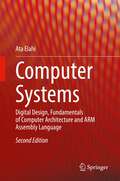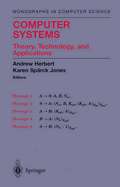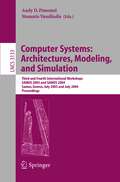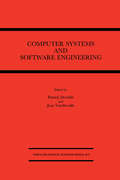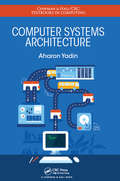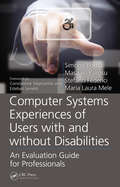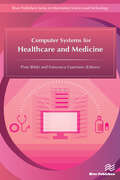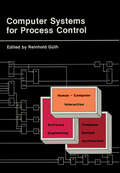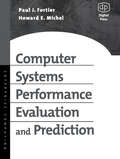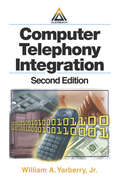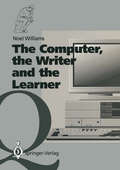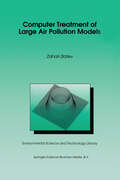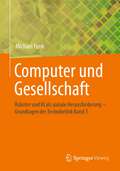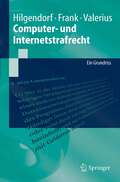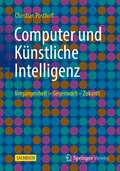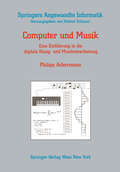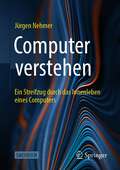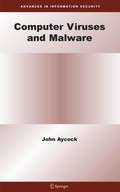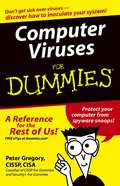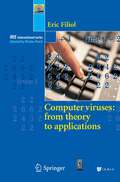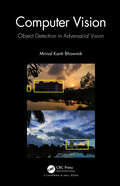- Table View
- List View
Computer Systems: Digital Design, Fundamentals of Computer Architecture and ARM Assembly Language
by Ata ElahiThis updated textbook covers digital design, fundamentals of computer architecture, and ARM assembly language. The book starts by introducing computer abstraction, basic number systems, character coding, basic knowledge in digital design, and components of a computer. The book goes on to discuss information representation in computing, Boolean algebra and logic gates, and sequential logic. The book also presents introduction to computer architecture, Cache mapping methods, and virtual memory. The author also covers ARM architecture, ARM instructions, ARM assembly language using Keil development tools, and bitwise control structure using C and ARM assembly language. The book includes a set of laboratory experiments related to digital design using Logisim software and ARM assembly language programming using Keil development tools. In addition, each chapter features objectives, summaries, key terms, review questions, and problems.
Computer Systems: Theory, Technology, and Applications (Monographs in Computer Science)
by Andrew James Herbert Karen I. B. Spaerck JonesAn invited collection of peer-reviewed papers surveying key areas of Roger Needham's distinguished research career at Cambridge University and Microsoft Research. From operating systems to distributed computing, many of the world's leading researchers provide insight into the latest concepts and theoretical insights--many of which are based upon Needham's pioneering research work. A critical collection of edited-survey research papers spanning the entire range of Roger Needham's distinguished scientific career, from operating systems to distributed computing and security. Many of the world's leading researchers survey their topics' latest developments and acknowledge the theoretical foundations of Needham's work. Introduction to book written by Rick Rashid, Director of Microsoft Research Worldwide.
Computer Systems: Third and Fourth International Workshop, SAMOS 2003 and SAMOS 2004, Samos, Greece, July 21-23, 2003 and July 19-21, 2004, Proceedings (Lecture Notes in Computer Science #3133)
by Andy Pimentel Stamatis VassiliadisComputer Systems and Software Engineering: State-of-the-art
by Patrick DeWilde Joos P. L. VandewalleComputer Systems and Software Engineering is a compilation of sixteen state-of-the-art lectures and keynote speeches given at the COMPEURO '92 conference. The contributions are from leading researchers, each of whom gives a new insight into subjects ranging from hardware design through parallelism to computer applications. The pragmatic flavour of the contributions makes the book a valuable asset for both researchers and designers alike. The book covers the following subjects: Hardware Design: memory technology, logic design, algorithms and architecture; Parallel Processing: programming, cellular neural networks and load balancing; Software Engineering: machine learning, logic programming and program correctness; Visualization: the graphical computer interface.
Computer Systems Architecture (Chapman & Hall/CRC Textbooks in Computing)
by Aharon YadinComputer Systems Architecture provides IT professionals and students with the necessary understanding of computer hardware. It addresses the ongoing issues related to computer hardware and discusses the solutions supplied by the industry. The book describes trends in computing solutions that led to the current available infrastructures, tracing the initial need for computers to recent concepts such as the Internet of Things. It covers computers’ data representation, explains how computer architecture and its underlying meaning changed over the years, and examines the implementations and performance enhancements of the central processing unit (CPU). It then discusses the organization, hierarchy, and performance considerations of computer memory as applied by the operating system and illustrates how cache memory significantly improves performance. The author proceeds to explore the bus system, algorithms for ensuring data integrity, input and output (I/O) components, methods for performing I/O, various aspects relevant to software engineering, and nonvolatile storage devices, such as hard drives and technologies for enhancing performance and reliability. He also describes virtualization and cloud computing and the emergence of software-based systems’ architectures. Accessible to software engineers and developers as well as students in IT disciplines, this book enhances readers’ understanding of the hardware infrastructure used in software engineering projects. It enables readers to better optimize system usage by focusing on the principles used in hardware systems design and the methods for enhancing performance.
Computer Systems Architecture (Chapman & Hall/CRC Textbooks in Computing)
by Aharon YadinComputer Systems Architecture provides IT professionals and students with the necessary understanding of computer hardware. It addresses the ongoing issues related to computer hardware and discusses the solutions supplied by the industry. The book describes trends in computing solutions that led to the current available infrastructures, tracing the initial need for computers to recent concepts such as the Internet of Things. It covers computers’ data representation, explains how computer architecture and its underlying meaning changed over the years, and examines the implementations and performance enhancements of the central processing unit (CPU). It then discusses the organization, hierarchy, and performance considerations of computer memory as applied by the operating system and illustrates how cache memory significantly improves performance. The author proceeds to explore the bus system, algorithms for ensuring data integrity, input and output (I/O) components, methods for performing I/O, various aspects relevant to software engineering, and nonvolatile storage devices, such as hard drives and technologies for enhancing performance and reliability. He also describes virtualization and cloud computing and the emergence of software-based systems’ architectures. Accessible to software engineers and developers as well as students in IT disciplines, this book enhances readers’ understanding of the hardware infrastructure used in software engineering projects. It enables readers to better optimize system usage by focusing on the principles used in hardware systems design and the methods for enhancing performance.
Computer Systems Experiences of Users with and Without Disabilities: An Evaluation Guide for Professionals
by Simone Borsci Masaaki Kurosu Stefano Federici Maria Laura MeleThis book provides the necessary tools for the evaluation of the interaction between the user who is disabled and the computer system that was designed to assist that person. The book creates an evaluation process that is able to assess the user's satisfaction with a developed system. Presenting a new theoretical perspective in the human computer i
Computer Systems for Healthcare and Medicine
by Piotr Bilski Francesca GuerrieroThe development of modern civilization leads to us having to solve new problems which did not exist before. The contemporary world faces a great challenge of aging societies, where the increasing number of citizens requires constant medical attention. To ensure safety and wellbeing of elderly people, patients in hospitals and disabled persons, advanced technologies can be implemented. These include both sophisticated data acquisition systems and data processing algorithms, aiming at the constant and discreet monitoring of persons whilst raising alarm if immediate attention is required.Computer Systems for Healthcare and Medicine presents a novel look at the introduced problems, including proposed solutions in the form of automated data acquisition and processing systems, which were tested in various environments. Characteristic features include a wide range of sensors used to monitor the situation of the person, and accurate decision making algorithms, often based on the computational intelligence domain. Technical topics discussed in the book include application for the healthcare of the following:Infrared sensorsMEMSUltra wideband radarsDeep learningDecision treesArtificial neural networksGabor filtersDecision support systems
Computer Systems for Healthcare and Medicine
The development of modern civilization leads to us having to solve new problems which did not exist before. The contemporary world faces a great challenge of aging societies, where the increasing number of citizens requires constant medical attention. To ensure safety and wellbeing of elderly people, patients in hospitals and disabled persons, advanced technologies can be implemented. These include both sophisticated data acquisition systems and data processing algorithms, aiming at the constant and discreet monitoring of persons whilst raising alarm if immediate attention is required.Computer Systems for Healthcare and Medicine presents a novel look at the introduced problems, including proposed solutions in the form of automated data acquisition and processing systems, which were tested in various environments. Characteristic features include a wide range of sensors used to monitor the situation of the person, and accurate decision making algorithms, often based on the computational intelligence domain. Technical topics discussed in the book include application for the healthcare of the following:Infrared sensorsMEMSUltra wideband radarsDeep learningDecision treesArtificial neural networksGabor filtersDecision support systems
Computer Systems for Process Control
by Reinhold GüthThe Brown Boveri Symposia are by now part of a firm!ly established tradition. This is the ninth event in a series which was initiated shortly after Corporate Research was created as a separate entity within our Company; the Symposia are held every other year. The themes to date have been: 1969 Flow Research on Blading 1971 Real-Time Control of Electric Power Systems 1973 High-Temperature Materials in Gas Turbines 1975 Nonemissive Electrooptic Displays 1977 Current Interruption in High-Voltage Networks 1979 Surges in High-Voltage Networks 1981 Semiconductor Devices for Power Conditionling 1983 Corrosion in Power Generating Equipment 1985 Computer Systems for Process Control Why have we chosen these topics? At the outset we established certain selection criteria; we felt that a subject for a symposium should fulfill the following three requirements: It should characterize a part of a thoroughly scientific discipline; in other words it should describe an area of scholarly study and research. r - It should be of current interest in the sense that important results have recently been obtained and considerable research effort is presently underway in the international scientific community. - It should bear some relation to the scientific and technological activity of our Company. Let us look at the requirement "current interest": Some of the topics on the list above have been the subject of research for several decades, some even from the - v vi FOREWORD ginning of the century.
Computer Systems Performance Evaluation and Prediction
by Paul Fortier Howard MichelComputer Systems Performance Evaluation and Prediction bridges the gap from academic to professional analysis of computer performance.This book makes analytic, simulation and instrumentation based modeling and performance evaluation of computer systems components understandable to a wide audience of computer systems designers, developers, administrators, managers and users. The book assumes familiarity with computer systems architecture, computer systems software, computer networks and mathematics including calculus and linear algebra.· Fills the void between engineering practice and the academic domain's treatment of computer systems performance evaluation and assessment· Provides a single source where the professional or student can learn how to perform computer systems engineering tradeoff analysis· Allows managers to realize cost effective yet optimal computer systems tuned to a specific application
Computer Telephony Integration
by William A. Yarberry Jr.Since the publication of the first edition, the CTI world has changed significantly. Where it was once focused on the integration of voice systems with computers, the focus is now on IP-based voice, or converged networks and services. Today, the telcos are upgrading their systems from circuit-switched to IP-based packet-switched networks. Companies
The Computer, the Writer and the Learner
by Noel WilliamsComputers are gradually infiltrating all stages of the writing process. Increasingly, teachers, writers, students, software developers, technical authors, and computer scientists need to learn more about the effective use of computers for writing. This book discusses how computers can help support writing. It explores the issues associated with using computers to train and help writers, concentrating on computational and user aspects and reviewing practical, economic and institutional issues. Noel Williams balances theoretical and practical concerns, to meet the needs of researchers and practising trainers of writing. There is also a brief evaluation available software products, together with advice about the major considerations and pitfalls of working on custom-made software. The book is based on five years of research by the Communication and Information Research Group (CIRG) at Sheffield City Polytechnic into the value of computer-based approaches to training and helping writers. The work was funded and supported by the Training Agency, IBM, AT&T, Rolls Royce, NAB and GEC. The Computer, the Writer and the Learner is for people who are using, or are thinking of using, computers to teach or support writing, and for designers of computer-based writing systems. Many such people are unaware of the nature and use of existing systems, and of the possibilities they offer. Developers often lack detailed knowledge of other projects and of the range of users' needs. Although the bias of the book is towards the teacher, trainer and student, most of the content deals with issues that developers will want to know about.
Computer Treatment of Large Air Pollution Models (Environmental Science and Technology Library #2)
by Zahari Zlatev"Models are often the only way of interpreting measurements to in vestigate long-range transport, and this is the reason for the emphasis on them in many research programs". B. E. A. Fisher: "A review of the processes and models of long-range transport of air pollutants", Atmospheric Environment, 17(1983), p. 1865. Mathematical models are (potentially, at least) powerful means in the efforts to study transboundary transport of air pollutants, source-receptor relationships and efficient ways of reducing the air pollution to acceptable levels. A mathematical model is a complicated matter, the development of which is based on the use of (i) various mechanisms describing mathematically the physical and chemical properties of the studied phenomena, (ii) different mathematical tools (first and foremost, partial differenti al equations), (iii) various numerical methods, (iv) computers (especially, high-speed computers), (v) statistical approaches, (vi) fast and efficient visualization and animation techniques, (vii) fast methods for manipulation with huge sets of data (input data, intermediate data and output data).
Computer und Gesellschaft: Roboter und KI als soziale Herausforderung – Grundlagen der Technikethik Band 3
by Michael FunkWelche Wirkungen haben Robotik und Künstliche Intelligenz (KI) auf die Gesellschaft? Wie verändern Algorithmen und Machine Learning unser soziales Umfeld? Vor welchen ethischen Herausforderungen stehen wir? Vorliegendes Buch bietet zu diesen und weiteren Fragen systematische Analysen. Allgemeine und spezielle Roboterkonzepte von Androiden über Social Robots bis hin zu kollaborativen Industrierobotern werden vorgestellt. Hinzu treten Drohnen im militärischen und zivilen Einsatz sowie diverse Formen der Mensch-Maschine-, Tier-Maschine- und Pflanze-Maschine-Interaktion. Verschiedene Begriffe und Paradigmen der KI werden auch abseits der Informatik herausgearbeitet, reale und spekulative Entwicklungen eingeordnet. Vor diesem Hintergrund geraten ethisch-gesellschaftliche Brennpunkte in den Blick. Beispiele, Aufgaben, vertiefende Infos zu Hintergründen und Übersichten laden zum kritischen Weiterdenken ein. Es bildet den dritten, in sich abgerundeten Teil der Buchreihe Grundlagen der Technikethik.Haben wir die Zukunft, die wir brauchen, und brauchen wir die Zukunft, die wir haben?
Computer- und Internetstrafrecht: Ein Grundriss (Springer-Lehrbuch)
by Eric Hilgendorf Thomas Frank Brian ValeriusDie moderne Informations- und Kommunikationstechnologie stellt das Recht vor neue Herausforderungen. Das Lehrbuch vermittelt einen umfassenden und zugleich detaillierten Überblick über das Computer- und Internetstrafrecht, angefangen vom klassischen Computerbetrug und Hacking von Daten bis hin zu den jüngsten kriminellen Erscheinungsformen wie Domain-Hijacking und Phishing. Darüber hinaus widmet es sich auch künftigen Entwicklungen, vor allem der zunehmenden Internationalisierung des Rechts auf diesem Gebiet.
Computer und Künstliche Intelligenz: Vergangenheit - Gegenwart - Zukunft
by Christian PosthoffDas Buch beginnt mit einer Erklärung der menschlichen Intelligenz und der Beschreibung von Intelligenztests. Die Künstliche Intelligenz, die auf Computerprogrammen beruht, beginnt mit der Dartmouth – Konferenz 1956, an der sich berühmte Informatiker dieser Zeit beteiligten. Diese damit eingeleitete Entwicklung wurde von großen Fortschritten der Kybernetik und der Spieltheorie begleitet.Es folgen Beschreibungen wichtiger Methoden und Anwendungen:Maschinelles Lernen und Neuronale Netze Sehr publikumswirksam waren die Entwicklungen von Programmen für strategische Spiele, die nach einem kurzen Training die jeweiligen Weltmeister besiegen konnten. Die Sprachübersetzer von Google und DeepL sind mittlerweile vielen bekannt. Es wird erklärt, wie intelligente Systeme mit Datenbanken zusammenarbeiten, wie beliebige Daten digitalisiert werden können. Große Mengen an Daten werden unter dem Stichwort „Big Data“ behandelt. Ausführlich beschrieben werden die Bildverarbeitung, die Erkennung von Tumoren und Viren. Robotik ist ein weiterer Punkt, der ausführlich dargestellt wird. Roboter in der Chirurgie und in der Pflege sind ebenfalls sehr bedeutsam. „Exotische Ausreißer“ sind die Anwendungen in der Kunst. Sehr bedeutsam für die zukünftige Entwicklung sind Anwendungen in der Rechtssprechung.
Computer und Musik: Eine Einführung in die digitale Klang- und Musikverarbeitung (Springers Angewandte Informatik)
by Philipp AckermannComputer verstehen: Ein Streifzug durch das Innenleben eines Computers
by Jürgen NehmerDieses Sachbuch ist eine leicht verständliche Einführung in die grundsätzliche Arbeitsweise von modernen Computern und Computernetzen, das keine Vorkenntnisse voraussetzt. Es richtet sich an neugierige, technisch interessierte Computer-Laien, aber auch an Schüler vor ihrer Berufswahl und Personen, die sich für eine berufliche Laufbahn im IT-Bereich interessieren.Der in 16 übersichtlichen Kapiteln gestaltete Streifzug durch das Innenleben der modernen Computerwelt beginnt bei der Hardware-Architektur eines Computers und führt über Betriebssysteme und Computernetzwerke mit Schwerpunkt Internet bis hin zu Internetanwendungen und den zugrunde liegenden Softwaretechnologien.Eine Besonderheit des Sachbuches ist dessen Fokussierung auf grundlegende Konzepte aus der Computerwelt. Fachtermini werden sparsam benutzt, dann aber auch erklärt. Auf produkt- und herstellerspezifische Details wird nur eingegangen, wenn sie sich als Quasi-Standards in heutigen Computersystemen durchgesetzt haben. Notwendige mathematische Betrachtungen zur Zahlendarstellung in Computern übersteigen nicht das Niveau elementarer Schulmathematik.
Computer Viruses and Malware (Advances in Information Security #22)
by John AycockOur Internet-connected society increasingly relies on computers. As a result, attacks on computers from malicious software have never been a bigger concern. Computer Viruses and Malware draws together hundreds of sources to provide an unprecedented view of malicious software and its countermeasures. This book discusses both the technical and human factors involved in computer viruses, worms, and anti-virus software. It also looks at the application of malicious software to computer crime and information warfare. Computer Viruses and Malware is designed for a professional audience composed of researchers and practitioners in industry. This book is also suitable as a secondary text for advanced-level students in computer science.
Computer Viruses For Dummies
by Peter H. GregoryComputer viruses—just the thought of your trusty PC catching one is probably enough to make you sick. Thanks to the cyber-sickies who persist in coming up with new strains, there’s a major new cyberattack nearly every day. Viruses sneak in, usually through e-mail. Fortunately, there are ways to inoculate and protect your computer. Computer Viruses For Dummies helps you: Understand the risks and analyze your PC’s current condition Select, install, and configure antivirus software Scan your computer and e-mail Rid your computer of viruses it’s already caught Update antivirus software and install security patches Use firewalls and spyware blockers Protect handheld PDAs from viruses Adopt safe computing practices, especially with e-mail and when you’re surfing the Net Written by Peter H. Gregory, coauthor of CISSP For Dummies and Security + For Dummies, Computer Viruses For Dummies goes beyond viruses to explain other nasty computer infections like Trojan horses, HiJackers, worms, phishing scams, spyware, and hoaxes. It also profiles major antivirus software to help you choose the best program(s) for your needs. Remember, if you don’t protect your computer, not only do you risk having your computer infiltrated and your data contaminated, you risk unknowingly transmitting a virus, worm, or other foul computer germ to everybody in your address book! This guide will help you properly immunize your PC with antivirus software now and install updates and security patches that are like booster shots to keep your software protected against new viruses.
Computer Viruses For Dummies
by Peter H. GregoryComputer viruses—just the thought of your trusty PC catching one is probably enough to make you sick. Thanks to the cyber-sickies who persist in coming up with new strains, there’s a major new cyberattack nearly every day. Viruses sneak in, usually through e-mail. Fortunately, there are ways to inoculate and protect your computer. Computer Viruses For Dummies helps you: Understand the risks and analyze your PC’s current condition Select, install, and configure antivirus software Scan your computer and e-mail Rid your computer of viruses it’s already caught Update antivirus software and install security patches Use firewalls and spyware blockers Protect handheld PDAs from viruses Adopt safe computing practices, especially with e-mail and when you’re surfing the Net Written by Peter H. Gregory, coauthor of CISSP For Dummies and Security + For Dummies, Computer Viruses For Dummies goes beyond viruses to explain other nasty computer infections like Trojan horses, HiJackers, worms, phishing scams, spyware, and hoaxes. It also profiles major antivirus software to help you choose the best program(s) for your needs. Remember, if you don’t protect your computer, not only do you risk having your computer infiltrated and your data contaminated, you risk unknowingly transmitting a virus, worm, or other foul computer germ to everybody in your address book! This guide will help you properly immunize your PC with antivirus software now and install updates and security patches that are like booster shots to keep your software protected against new viruses.
Computer Viruses: from theory to applications (Collection IRIS)
by Eric FiliolA precise and exhaustive description of different types of malware from three different points of view, namely the theoretical fundamentals of computer virology, algorithmic and practical aspects of viruses and their potential applications to various areas.
Computer Vision: Object Detection In Adversarial Vision
by Mrinal Kanti BhowmikThis comprehensive textbook presents a broad review of both traditional (i.e., conventional) and deep learning aspects of object detection in various adversarial real-world conditions in a clear, insightful, and highly comprehensive style. Beginning with the relation of computer vision and object detection, the text covers the various representation ofobjects, applications of object detection, and real-world challenges faced by the research community for object detection task. The book addresses various real-world degradations and artifacts for the object detection task and also highlights the impacts of artifacts in the object detection problems. The book covers various imaging modalities and benchmark datasets mostly adopted by the research community for solving various aspects of object detection tasks. The book also collects together solutions and perspectives proposed by the preeminent researchers in the field, addressing not only the background of visibility enhancement but also techniques proposed in the literature for visibility enhancement of scenes and detection of objects in various representative real-world challenges.Computer Vision: Object Detection in Adversarial Vision is unique for its diverse content, clear presentation, and overall completeness. It provides a clear, practical, and detailed introduction and advancement of object detection in various representative challenging real-world conditions.Topics and Features:• Offers the first truly comprehensive presentation of aspects of the object detection in degraded and nondegraded environment.• Includes in-depth discussion of various degradation and artifacts, and impact of those artifacts in the real world on solving the object detection problems.• Gives detailed visual examples of applications of object detection in the real world.• Presents a detailed description of popular imaging modalities for object detection adopted by researchers.• Presents the key characteristics of various benchmark datasets in indoor and outdoor environment for solving object detection tasks.• Surveys the complete field of visibility enhancement of degraded scenes, including conventional methods designed for enhancing the degraded scenes as well as the deep architectures. • Discusses techniques for detection of objects in real-world applications.• Contains various hands-on practical examples and a tutorial for solving object detection problems using Python.• Motivates readers to build vision-based systems for solving object detection problems in degraded and nondegraded real-world challenges.The book will be of great interest to a broad audience ranging from researchers and practitioners to graduate and postgraduate students involved in computer vision tasks with respect to object detection in degraded and nondegraded real-world vision problems.
Computer Vision: Object Detection In Adversarial Vision
by Mrinal Kanti BhowmikThis comprehensive textbook presents a broad review of both traditional (i.e., conventional) and deep learning aspects of object detection in various adversarial real-world conditions in a clear, insightful, and highly comprehensive style. Beginning with the relation of computer vision and object detection, the text covers the various representation ofobjects, applications of object detection, and real-world challenges faced by the research community for object detection task. The book addresses various real-world degradations and artifacts for the object detection task and also highlights the impacts of artifacts in the object detection problems. The book covers various imaging modalities and benchmark datasets mostly adopted by the research community for solving various aspects of object detection tasks. The book also collects together solutions and perspectives proposed by the preeminent researchers in the field, addressing not only the background of visibility enhancement but also techniques proposed in the literature for visibility enhancement of scenes and detection of objects in various representative real-world challenges.Computer Vision: Object Detection in Adversarial Vision is unique for its diverse content, clear presentation, and overall completeness. It provides a clear, practical, and detailed introduction and advancement of object detection in various representative challenging real-world conditions.Topics and Features:• Offers the first truly comprehensive presentation of aspects of the object detection in degraded and nondegraded environment.• Includes in-depth discussion of various degradation and artifacts, and impact of those artifacts in the real world on solving the object detection problems.• Gives detailed visual examples of applications of object detection in the real world.• Presents a detailed description of popular imaging modalities for object detection adopted by researchers.• Presents the key characteristics of various benchmark datasets in indoor and outdoor environment for solving object detection tasks.• Surveys the complete field of visibility enhancement of degraded scenes, including conventional methods designed for enhancing the degraded scenes as well as the deep architectures. • Discusses techniques for detection of objects in real-world applications.• Contains various hands-on practical examples and a tutorial for solving object detection problems using Python.• Motivates readers to build vision-based systems for solving object detection problems in degraded and nondegraded real-world challenges.The book will be of great interest to a broad audience ranging from researchers and practitioners to graduate and postgraduate students involved in computer vision tasks with respect to object detection in degraded and nondegraded real-world vision problems.
